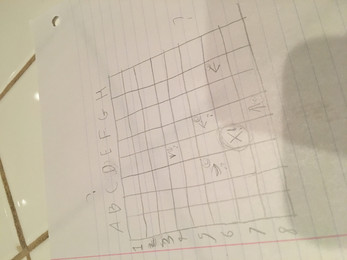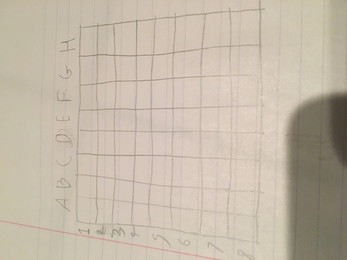Sabotage.
A downloadable game
Sabotage is a pen and paper game of psychology, wits, and chance. I developed this with a few friends over the summer, and we've been having a lot of fun with it.
The game pits two players against each other on the 8x8 graph board as a hider and a seeker. The hider will pick a tile on the board and write it down (to prevent cheating!), then the seeker will begin guessing which tile the hider has hidden it in. The twist is that the hider must give a cardinal direction with each guess the seeker makes. This cardinal direction needs to be pointing in the direction of the hidden tile, but it doesn't need to be GOOD directions.
Say the seeker's last guess is two to the west, and one to the south of the hidden tile, the hider can say either west or south, and would be well served to pick the direction that they think would throw the opponent off course the most.
As the seeker gets close to finding the hidden tile, the hider is allowed to declare a relocation once per game. The board resets, but the turns the seeker spent remain. The seeker can relocate at any time except when the hider is picking a square, making it a game of risk vs reward whether to relocate early, or squeeze out as many turns as possible from the system.
The goal of the hider's game is to make the seeker take as many guesses as possible to find the right tile, by way of giving the worst directions you can while still being technically true. The seeker's goal is to use chance and other methods to find the hidden tile as quickly as possible. At the end of the round, the two players switch roles and whoever has the lowest number of turns as the seeker after two rounds wins.
Sabotage is simple and quick to set up, and the rules can be explained to a new player within three minutes.
The screenshots show the first draft of our game, the final board, and a game in progress. In our early drafts, we were making a game similar to Battleship, but we found the gameplay grew stale after a few rounds. When we changed the game to be an early version of what you see in the ruleset below, we found it had much more replayability by adding in factors like psychology and probability into the mix. We did this by not putting a wall up between the players, so they can gauge each other's reactions and make deductions from it; we also introduced the mechanic that the hider needs to somewhat guide the seeker to the hidden tile, making every decision on either side a probability dilemma.
| Status | Released |
| Author | RileyDix |
| Genre | Strategy |
| Tags | Board Game, printnplay |


